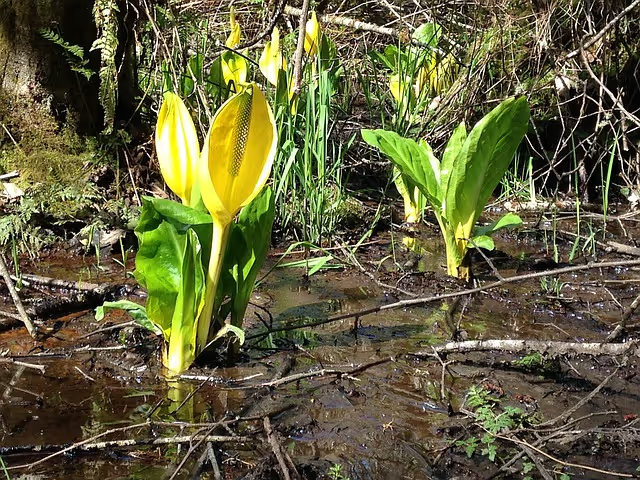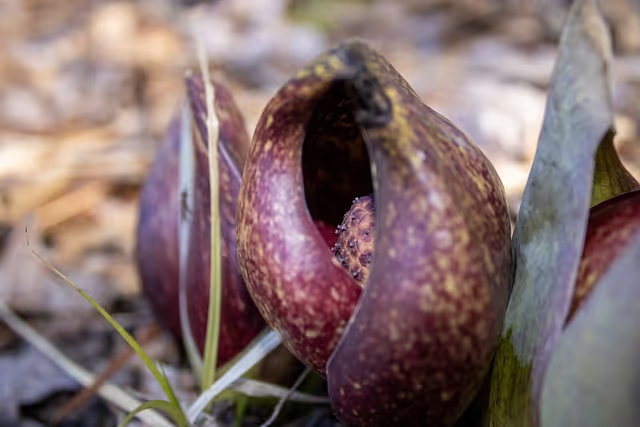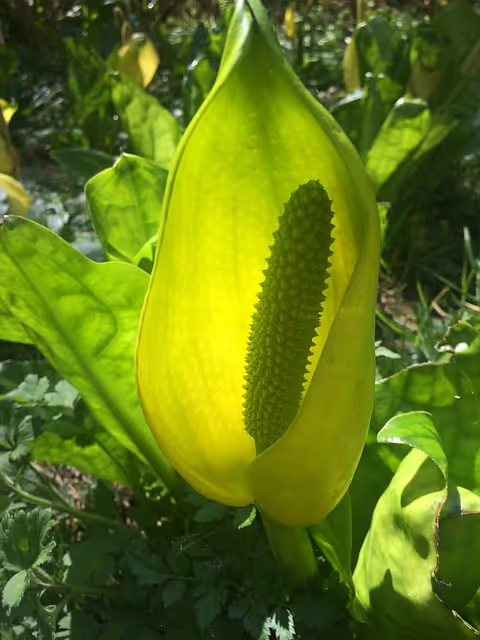Skunk Cabbage


Anyone who has ever had the misfortune of encountering a Skunk knows that the most prominent thing about them is that they are quite odoriferous. Because of this, it might come as no surprise that a plant with the word "Skunk" in its name would also have an unpleasant odor. However, just because a plant smells bad doesn't mean that it doesn't have some benefits. In this post, we'll talk about what Skunk Cabbage is, how it can help your garden, and what to consider when deciding if it’s the right plant for you.

There are two common types of Skunk Cabbage: Eastern and Western. The Eastern variety (scientific name: Symplocarpus foetidus) is purple, and the Western variety (scientific name: Lysichiton americanus) is yellow. Both are perennial wildflowers that grow in wet, swampy areas of forest. The Eastern variety can be found in Eastern Canada, the northeastern United States, Minnesota, Tennessee, and North Carolina. The Western variety is the one that you will most likely encounter here, as it is found in the Western United States, Alaska, and British Columbia. Locally, you can find the Western variety at Lake Sylvia State Park in Montesano, and in wetland areas throughout the Grays Harbor region. Native Americans have used Skunk Cabbage as a medicinal treatment for headaches and coughs. In the 1800s, it was sold as a drug known as dracontium that was used to treat an array of ailments.

Skunk Cabbage is one of the first plants to sprout each spring. It has a unique ability to produce its own heat. This allows it to emerge and bloom, even if the ground is still frozen. During the winter months, the flower buds can warm up to 70 degrees Fahrenheit (21 degrees Celsius). This causes any snow that surrounds the plant to melt. The Skunk Cabbage is also unusual in that its flowers appear before its leaves do. The flowers are characterized by a roof-like leaf, known as a spathe. The spathe can be wine-red or maroon in color. It can also be mottled with stripes of patches of yellow or yellow green color. The spathe surrounds a fleshy spike of numerous flowers. This spike is known as a spadix. Initially, the flowers don't have pedals. As the flowers mature, the spathe opens to allow pollinators, such as flies and bees, to enter and pollinate the flowers. Pollinated flower heads develop berrylike fruits that contain seeds. The seeds germinate into new Skunk Cabbages during the next growing season. Once the Skunk Cabbage's leaves appear, it looks like a plain, green plant. The plant can live for up to twenty years, and loses its leaves annually.
Skunk Cabbages get their name from the fact they produce a smell of rotting meat or Skunk when its leaves are bruised or crushed. While this might seem revolting to you as a human, the unpleasant odor can help your garden in two ways.

While Skunk Cabbage may give your garden the benefits described above, it is not a plant to add to your garden without careful consideration. There are two reasons for this.
First, Skunk Cabbage is poisonous for humans, cats, dogs, and other mammals. In small doses, the plant can cause the mouth to burn and swell. A choking sensation may also result. Eating larger portions of Skunk Cabbage leaves can be fatal. Therefore, if you have young children or pets that spend time outside, Skunk Cabbage might not be the best plant for your garden.
Second, since our little piece of coastal paradise is home to a large population of deer who seemingly eat just about anything, we must take them into account when making decisions about our gardens. While planting Skunk Cabbage may help to keep squirrels and raccoons away, it will do nothing to keep deer at bay. This is because deer like to eat Skunk Cabbage. When the plant first emerges in the spring, they target the plant's yellow flower spike and green leaves. In the summer, deer will eat the leaves, with the center stem being the only part of the plant they won't touch. While these contain compounds that are poisonous for deer, they are also rich in protein, which deer need after getting through the winter season. While our beloved deer eating plants that could poison them may seem concerning, in this particular instance, it might not be. Because deer typically eat more than one type of vegetation at each meal, the combination of plants in their digestive tracts may reduce or eliminate the toxic effects that the Skunk Cabbage can produce. If it didn't, they would most likely have learned not to eat it.
References
https://www.gardeningknowhow.com/ornamental/flowers/skunk-cabbage/skunk-cabbage-facts.htm
https://www.natureinstitute.org/article/craig-holdrege/skunk-cabbage
https://www.nwf.org/Educational-Resources/Wildlife-Guide/Plants-and-Fungi/Skunk-Cabbage
http://www.adfg.alaska.gov/index.cfm?adfg=wildlifenews.view_article&articles_id=249
© Ian D. Caldwell, August 2021
Touch whale bones, examine shipwreck artifacts and connect with the coast's living history.

Support our mission, get involved in educational programs, or contribute through donations and volunteering.